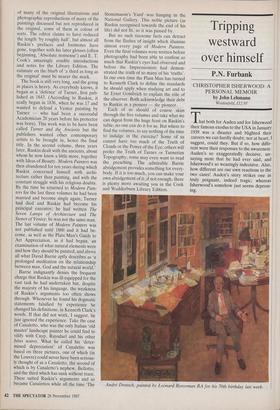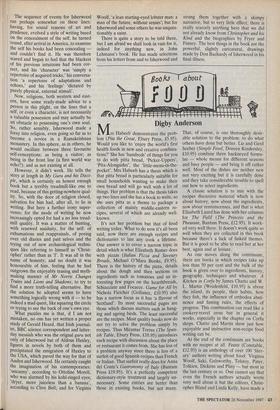Tripping westward over himself
P.N. Furbank
CHRISTOPHER ISHERWOOD: A PERSONAL MEMOIR by John Lehmann
Weidenfeld, £12.95
That both for Auden and for Isherwood their famous exodus to the USA in January 1939 was a disaster and blighted their careers we can hardly doubt; nor at heart, I suggest, could they. But if so, how diffe- rent were their responses to the awareness: Auden's so exaggeratedly decisive, un- saying most that he had ever said, and Isherwood's so wearingly indecisive. Also, how different are our own reactions to the two cases! Auden's story strikes one as truly poignant, indeed tragic; whereas Isherwood's somehow just seems depress- ing.
Andre Deutsch, painted by Leonard Rossoman RA for his 70th birthday last week. The sequence of events for Isherwood ran perhaps somewhat on these lines: having, for sound reasons of art and prudence, evolved a style of writing based on the concealment of the self, he turned round, after arrival in America, to examine the self his books had been concealing — and couldn't find it. He was therefore scared and began to feel that the blackest Of his previous intuitions had been cor- rect, and his 'character' was 'simply a repertoire of acquired tricks,' his conversa- tion 'a repertoire of adaptations and echoes,' and his 'feelings' dictated by purely physical, external stimuli'.
Now, religions, both western and east- ern, have some ready-made advice to a person in this plight, on the lines that a self, or even a character, is not necessarily a valuable possession and may actually be an obstacle to possessing one's own soul. So, rather sensibly, Isherwood made a foray into religion, even going so far as to become a novice in a Ramakrishnan monastery. In this sphere, as in others, he would oscillate between three favourite self-conceptions: as being a visitor; as being in the front line (a first world war echo?); and as not existing at all.
However, it didn't work. He tells the story at length in My Guru and his Disci- ple, which is certainly an honest enough book but a terribly treadmill-like one to read, because of this getting-nowhere qual- ity. So, with the door of religion closed, salvation for him had, after all, to lie in writing. But here a further irony super- venes; for the mode of writing he now increasingly opted for had a no less tread- mill quality. It was a matter of hunting, with renewed assiduity, for the self: of exhumations and reappraisals, of poring over old diaries and past selves and the trying out of new archaeological techni- ques like referring to himself as 'Christ- opher' rather than as 'I'. It was all in the name of honesty; and no doubt it was honourable of him, feeling that he had outgrown the enjoyably teasing and myth- making manner of Mr Norris Changes Trains and Lions and Shadows, to try to find a more truth-telling alternative. But the solution he adopted seems to have something logically wrong with it — to be indeed a mad quest, like squaring the circle or trying to see the back of one's own eye.
What puzzles me is that, if I am not mistaken, no one has yet written a proper study of Gerald Heard, that Irish journal- ist, BBC science correspondent and latter- day messiah who was the orignal guru not only of Isherwood but of Aldous Huxley, figures in novels by both of them and precipitated the emigration of Huxley to the USA, which paved the way for that of Auden and Isherwood. He certainly caught the imagination of his contemporaries: 'uncanny', according to Ottoline More11, who was alarmed by his kohl-ringed eyes; 'dryer, more juiceless than a banana', according to Clive Bell; and for Virginia Woolf, 'a lean starting-eyed lobster man: a man of the future, without senses'; but for Isherwood and some others he was unques- tionably a saint.
There is quite a story to be told there, but I am afraid we shall look in vain for it, indeed for anything new, in John Lehmann's book. He has made selections from his letters from and to Isherwood and strung them together with a skimpy narrative, but to very little effect; there is really scarcely anything here that we did not already know from Christopher and his Kind and the biographies by Fryer and Finney. The best things in the book are the powerful, slightly caricatural, drawings made by Don Bachardy of Isherwood in his final illness.



































































 Previous page
Previous page